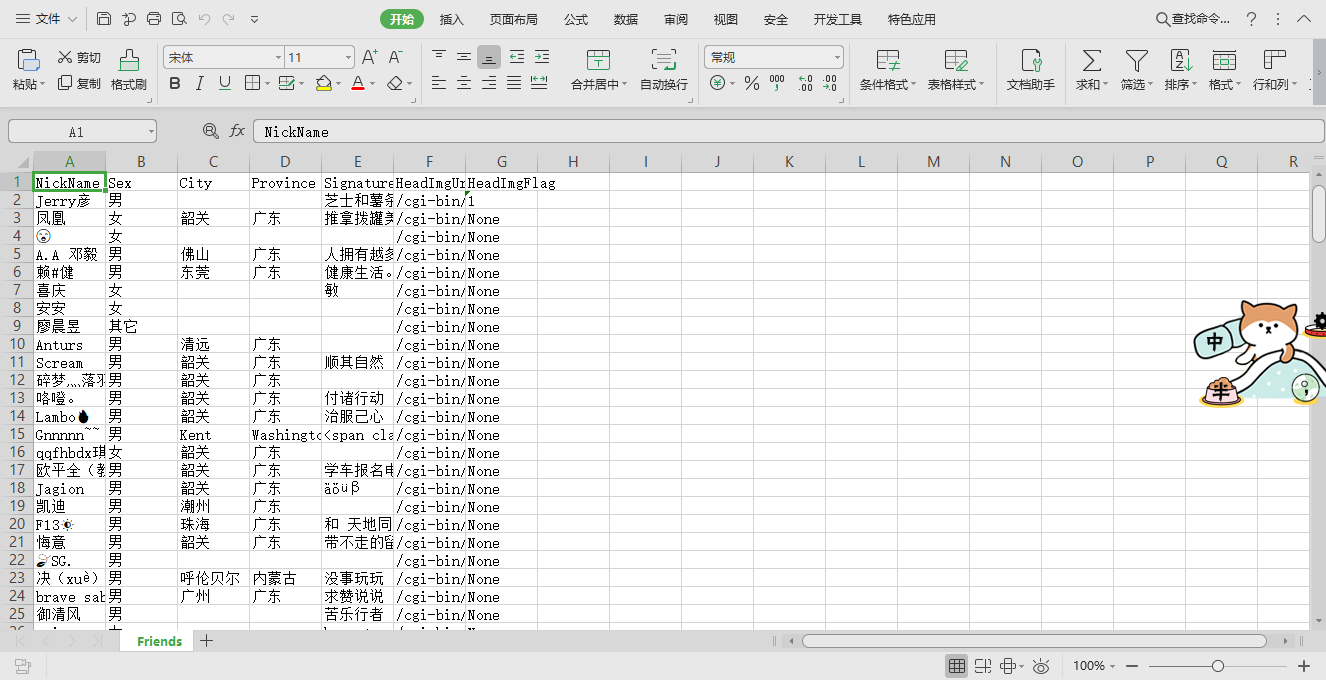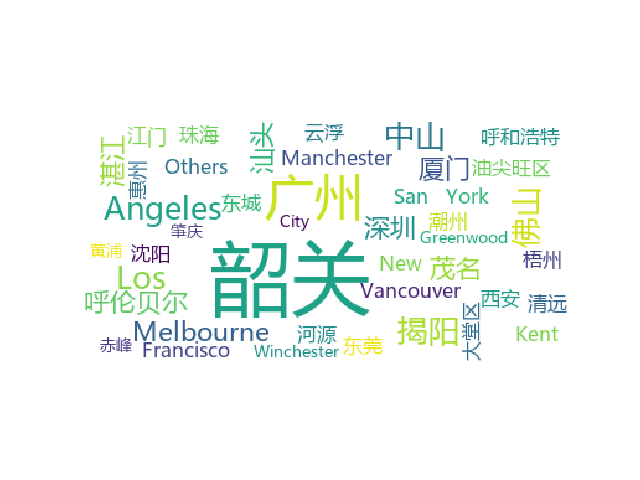微信好友分析
一.环境要求
Windows 10;python 3.7;
第三方库
wxpy 0.3.9.8——登录微信
openpyxl 2.6.2——可对 excel 表格进行操作
pyecharts 0.5.11——百度的开源可视化库,
wordcloud 1.5.0——词云制作库
matplotlib 3.1.0——生成词云图
pandas 0.24.2——读取 excel 表格的数据
pyecharts-snapshot 0.2.0——是 pyecharts 的依赖库之一
echarts-countries-pypkg——pyecharts 的世界地图包
echarts-china-provinces-pypkg——pyecharts 的中国省份地图包
第三方库的安装
(2019年6月10号)除了 pyecharts 其它都可以直接使用 pip 安装,而安装 pycharts 需要特殊些(因为最新版已出为 1.X版,不向下兼容),如下:
|
1
2
3
4
5
6
7
8
9
10
|
pip install wxpypip install openpyxlpip install PILpip install pandaspip install wordcloudpip install pyecharts==0.5.11pip install echarts-countries-pypkgpip install echarts-china-provinces-pypkgpip install pyecharts-snapshot |
二.分析思路
1.登录微信,获取好友的基本信息
使用 wxpy 的 Bot() 模块,登录微信
from wxpy import * bot = Bot(cache_path = True) #获取全部好友的信息 friend_all = bot.friends() #输出 friend_all 看一下 print(friend_all)
#输出好友数量
#print(len(friend_all))
输出结果为

2.把好友信息存为更易处理的二维列表
#建立一个二维列表,存储基本好友信息
lis = [['NickName','Sex','City','Province','Signature','HeadImgUrl','HeadImgFlag']]
#把好有特征数据保存为列表
for a_friend in friend_all:
#遍历 friend_all, 并使用 raw.get(' ', None), 来获取每一各朋友的基本信息
NickName = a_friend.raw.get('NickName', None)
Sex = {1:"男", 2:"女", 0:"其它"}.get(a_friend.raw.get('Sex', None), None)
City = a_friend.raw.get('City', None)
Province = a_friend.raw.get('Province', None)
Signature = a_friend.raw.get('Signature', None)
HeadImgUrl = a_friend.raw.get('HeadImgUrl', None)
HeadImgFlag = a_friend.raw.get('HeadImgFlag', None)
list_0 = [NickName, Sex, City, Province, Signature, HeadImgUrl, HeadImgFlag]
lis.append(list_0)
输出 lis

3.把列表存为 excel 表格,方便本地查看
#把列表转换为 xlsx 表格
def list_to_xlsx(filename, list):
import openpyxl
#新建一个表格
wb = openpyxl.Workbook()
sheet = wb.active
sheet.title = 'Friends'
file_name = filename + '.xlsx'
for i in range(0, len(list)):
for j in range(0, len(list[i])):
sheet.cell(row = i+1, column = j+1, value = str(list[i][j]))
wb.save(file_name)
print("读写数据成功")
#把列表生成表格
list_to_xlsx('wechat_friend', lis)
生成的表格为
4.对 execl 表格进行处理,利用表格信息生成词云
from wordcloud import WordCloud
import matplotlib.pyplot as plt
import pandas as pd
from pandas import read_excel
df = read_excel('wechat_friend.xlsx')
#使用 WordCloud 生成词云
word_list = df['City'].fillna('').tolist()
new_text = ' '.join(word_list)
wordcloud = WordCloud(font_path='msyh.ttc', background_color = 'white').generate(new_text)
plt.imshow(wordcloud)
plt.axis("off")
plt.show()
plt.savefig("WordCloud.png")
print("保存词云图")
词云图展示

5.利用表格信息生成网页词云图(即HTML)
#使用 pyecharts 生成词云
from pyecharts import WordCloud
city_list = df['City'].fillna('').tolist()
count_city = pd.value_counts(city_list)
name = count_city.index.tolist()
value = count_city.tolist()
wordcloud = WordCloud(width=1300,height=620)
wordcloud.add("",name,value,word_size_range=[20,100])
#wordcloud.show_config()
#wordcloud.render(r'D:\wc.html')
wordcloud.render('wordcloud.html')
print("网页词云图已生成")
词云图展示

6.利用表格信息生成好友地图分布图
#将好友展示在地图上
from pyecharts import Map
province_list = df['Province'].fillna('').tolist()
count_province = pd.value_counts(province_list)
attr = count_province.index.tolist()
value1 = count_province.tolist()
map = Map("各省微信好友分布", width=1200,height=600)
map.add("",attr, value1, maptype='china',is_visualmap=True,visualmap_text_color='#000',is_label_show=True)
#map.show_config()
map.render('map.html')
print("map已生成")
微信好友分布图展示
三.最后代码汇总
把上面的代码,规范一下,可得——
# -*- coding: utf-8 -*-
"""
Created on Mon Jun 3 10:01:35 2019
@author: haiwe
"""
#获取微信接口
from wxpy import *
#把获取的微信好友信息存为列表
def wx_friend_information(friend_all):
#先生成一个二维列表,用来储存好友信息
lis = [['NickName','Sex','City','Province','Signature','HeadImgUrl','HeadImgFlag']]
#遍历 friend_all, 并使用 raw.get(' ', None), 来获取每一各朋友的基本信息
for a_friend in friend_all:
NickName = a_friend.raw.get('NickName', None)
Sex = {1:"男", 2:"女", 0:"其它"}.get(a_friend.raw.get('Sex', None), None)
City = a_friend.raw.get('City', None)
Province = a_friend.raw.get('Province', None)
Signature = a_friend.raw.get('Signature', None)
HeadImgUrl = a_friend.raw.get('HeadImgUrl', None)
HeadImgFlag = a_friend.raw.get('HeadImgFlag', None)
list_0 = [NickName, Sex, City, Province, Signature, HeadImgUrl, HeadImgFlag]
lis.append(list_0)
return lis
#把列表转换为 xlsx 表格,并保存表格
def list_to_xlsx(filename, list):
#使用 openpyxl 创建空表格
import openpyxl
wb = openpyxl.Workbook()
#获得当前正在显示的 sheet, 或 wb.get_active_sheet()
sheet = wb.active
#表格的 sheet 页命名为 Friends
sheet.title = 'Friends'
# execl 文件命名
file_name = filename + '.xlsx'
#遍历 excel 表格,并读入数据
for i in range(0, len(list)):
for j in range(0, len(list[i])):
#为什么 i+1,j+1 不懂
sheet.cell(row = i+1, column = j+1, value = str(list[i][j]))
#保存表格
wb.save(file_name)
print("读写数据成功")
from wordcloud import WordCloud
import matplotlib.pyplot as plt
import pandas as pd
#使用 pandas 的 read_excel 模块读取execl 表格
from pandas import read_excel
#import numpy as np
#生成词云图
def create_wordcloud(df):
#把 df(dataframe) 中城市那列中 为空的 替换为 空字符,并把替换后的城市列存在 city_list中
word_list = df['City'].fillna('').tolist()
#把 city_list 列表中的 各项 用空格隔开,并变为字符串
new_text = ' '.join(word_list)
#设置词云图的字体为 ‘msyh.ttc', 背景为白色(默认为黑色),并用 generate() 生成词云图
wordcloud = WordCloud(font_path='msyh.ttc', background_color = 'white').generate(new_text)
#展示生成的词云图
plt.imshow(wordcloud)
#plt.axis("off")
#plt.show()
plt.savefig("WordCloud.png")
print("保存词云图")
#使用 pyecharts 生成词云
def create_wordcloud_html(df):
#调用 pyecharts 中 wordcloud 模块
from pyecharts import WordCloud
#把 df(dataframe) 中城市那列中 为空的 替换为 空字符,并把替换后的城市列存在 city_list中
city_list = df['City'].fillna('').tolist()
#使用 pandas.value_count() 返回 city_list 中各项和其对应的频数(两者一一对应),并存在 count_city 中
count_city = pd.value_counts(city_list)
#把 count_city 中的项提取出来,并存在 name 中
name = count_city.index.tolist()
#把 count_city 中的频数提取出来
value = count_city.tolist()
#生成词云图
wordcloud = WordCloud(width=1300,height=620)
#往词云图中添加信息,
wordcloud.add("",name,value,word_size_range=[20,100])
#输出词云图的配置
#wordcloud.show_config()
#wordcloud.render(r'D:\wc.html')
#保存词云图
wordcloud.render('wordcloud.html')
print("网页词云图已生成")
#将好友展示在地图上
def create_map(df):
#使用 pyechart 的 Map 模块,生成网页词云图
from pyecharts import Map
#把 df(dataframe) 中省份那列中 为空的 替换为 空字符,并把替换后的城市列存在 province_list中
province_list = df['Province'].fillna('').tolist()
#使用 pandas.value_count() 返回 province_list 中各项和其对应的频数(两者一一对应),并存在 count_province 中
count_province = pd.value_counts(province_list)
#把 count_province 中的项提取出来,并存在 name 中
attr = count_province.index.tolist()
#把 count_province 中的频数提取出来
value1 = count_province.tolist()
#生成一个标题为 “ ”的空白 HTML
map = Map("各省微信好友分布", width=1200,height=600)
#向空白 HTML 中添加 信息,设置地图为 中国地图,并显示地图,设置地图上文字颜色,并显示标签
map.add("",attr, value1, maptype='china',is_visualmap=True,visualmap_text_color='#000',is_label_show=True)
#map.show_config()
#保存词云网页
map.render('map.html')
print("map已生成")
if __name__ == "__main__":
#获取登录二维码
bot = Bot(cache_path = True)
#获取微信朋友的基本数据
friend_all = bot.friends()
list = wx_friend_information(friend_all)
list_to_xlsx('wechat_friend', list)
df = read_excel('wechat_friend.xlsx')
create_wordcloud(df)
create_wordcloud_html(df)
create_map(df)





 浙公网安备 33010602011771号
浙公网安备 33010602011771号